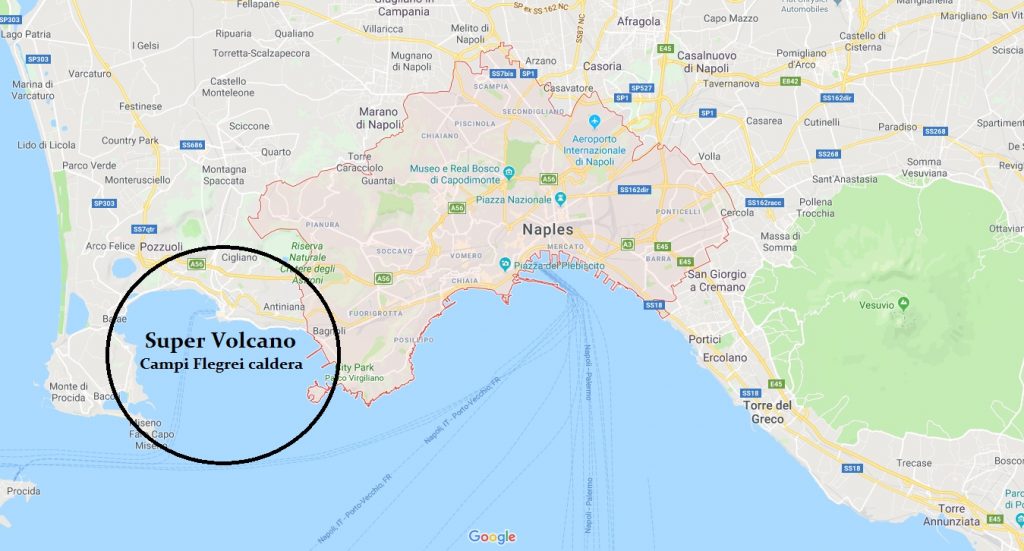QUESTION: Marty, Your computer warned that we would be heading into global cooling, not warming. But you also warned that we would see increased volcanic activity and the risk of a volcanic winter. Well, this has been the coldest winter I can remember. With Mt Spurr stirring, another offshore from California, and some hinting at Yellowstone erupting, do you have any update on this aspect from Socrates?
Darby
ANSWER: Nothing has changed. We are heading into a more active volcano period, and that does raise the risk of a volcanic winter in which crops fail, and there will be a shortage of food. I still recommend that you stockpile two years’ worth of food. It is not that you will save money, but that the supply may be seriously diminished. Our models of Wheat warn that this year is the Directional Change, and we can see a shortage into 2028.
However, there are rising concerns about the Supervolcano in Italy that appears to be coming to life. A 4.4-magnitude earthquake struck Italy’s Campi Flegrei supervolcano Monday evening. It was at a depth of 3 kilometers, which is the strongest earthquake to hit the area in the past 40 years, according to INGV data. The quake is part of an ongoing “seismic storm” that has seen over a dozen events over 2.0 magnitude in the past 48 hours. The eruption of Mr Vesusius, who buried Pompeii in 79AD, is related to this region. As far as Yellowstone Supervolcano is concerned, it has been showing some more minor activity, but nothing major just yet.
During January 2025, the University of Utah Seismograph Stations, responsible for the operation and analysis of the Yellowstone Seismic Network, located 56 earthquakes in the Yellowstone National Park region. The largest event of the month was a minor earthquake of magnitude 3.7. I would be more concerned about Italy just yet.
There are a number of Supervolcanoes around the world and perhaps the most recent one to erupt was in Italy. The term Supervolcano has been popularized by the BBC and the Discovery Channel story on Yellowstone back in 2005. According to the United States Geological Survey (USGS), a supervolcano is any volcanic center that has explosively erupted at least 1,000 cubic kilometers (240 cubic miles) of fresh volcanic material in a sudden, violent manner – in a so-called supereruption – often producing a huge depression crater named a caldera. Currently, Italy’s Campi Flegrei volcano has been showing signs for the first time in nearly 400 years that it is still alive and well and capable of making a lot of people experience a very bad day.
Aside from Yellowstone, the largest volcanic eruption in the Northern Hemisphere in the past 100,000 years has been attributed to a Supervolcano, which erupted some 39,400 years ago in what is known as the Phlegraean Fields by Naples, Italy. This has been documented from several sources. The ashes from this eruption were distributed over the entire eastern Mediterranean and up to central Russia. This was a huge event that clearly also produced a Volcanic Winter, and that is what is the worst thing for the rest of the world who resides at a safe distance from the actual Supervolcano.
We are beginning to witness a rise in volcanic activity as we enter solar minimum. Hopefully, we are not facing a catastrophic volcanic winter period. But it also does raise some concerns that a pole shift can be far more rapid than previously anticipated. I believe that people prefer to assume uniformity rather than a catastrophe. A stalagmite-based paleomagnetic record of the post-Blake excursion reveals details of repeated polarity drifts have occurred during periods of low geomagnetic field intensity at 100 thousand years before present around the time of this Naples eruption. One surprisingly abrupt centennial reversal transition occurred in 144,000 provides unprecedented evidence that raises fundamental questions about the speed of geomagnetic field shifts. Such rapid polarity changes could severely affect satellites and human society in the future if the current geomagnetic field intensity continues to decrease.
We have a pole shift, climate change, and volcanic eruptions seem to be interlinked on a correlated basis. Our correlation models have warned that this is something that needs to be investigated. For the first time, laying out this record produces what appears to be a single geological archive creating a precise chronological order. These types of events can take place in the space of even just a single decade.
The recent events at the Campi Flegrei volcano have provided a warning sign for the first time in nearly 400 years. The ground at the caldera’s center has bulged by 4 meters, warning that lava is collecting again. This uplifting interestingly began in 1985 with this ECM wave. Keep in mind that the eruptions at the Supervolcanic level took place around 315,000, 205,000, 157,000, and 18,000 years ago. A minor event is still at the level of Vesuvius. So, while we no doubt face a major Supervolcanic event, that level may still be off several thousands of years into the future. What is emerging now is more likely to be an important event, but not at the Supervolcanic level.












